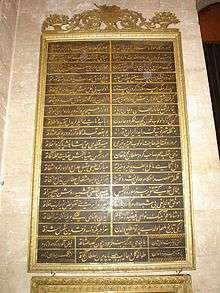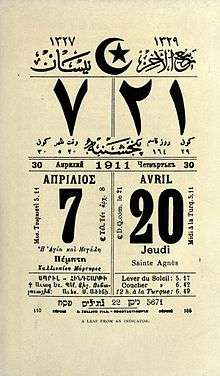Languages of the Ottoman Empire
| Languages of Ottoman Empire | |
|---|---|
 A poem about Rumi in Ottoman Turkish. | |
| Official languages | Ottoman Turkish |
| Minority languages | Albanian, Arabic, Armenian, Assyrian, Western Neo-Aramaic, Berber, Bosnian, Bulgarian, Cappadocian Greek, all the Caucasian languages, Coptic, Crimean Tatar, Croatian, Domari, Gagauz, Georgian, German, Greek, Hebrew, Hungarian, Italian languages, Judeo-Arabic, Judaeo-Spanish, Kurdish, Latin,[dn 1] Laz, Persian, Polish, Pontic Greek, Romanian, Russian, Ruthenian, Serbian, Slovak, Ukrainian, Urum, Vlach, Yevanic, Zazaki |
The language of the court and government of the Ottoman Empire was Ottoman Turkish,[1] but many other languages were in contemporary use in parts of the empire. Although the minorities of the Ottoman Empire were free to use their language amongst themselves, if they needed to communicate with the government they had to use Ottoman Turkish.[2]
The Ottomans had three influential languages: Turkish, spoken by the majority of the people in Anatolia and by the majority of Muslims of the Balkans except in Albania, Bosnia, and various Aegean Sea islands; Persian, only spoken by the educated;[3] and Arabic, spoken mainly in Arabia, North Africa, Mesopotamia and the Levant. Throughout the vast Ottoman bureaucracy Ottoman Turkish language was the official language, a version of Turkish, albeit with a vast mixture of both Arabic and Persian grammar and vocabulary.
Virtually all intellectual and literate pursuits were taken in Turkish language. Some ordinary people had to hire special "request-writers" (arzuhâlcis) to be able to communicate with the government.[4] The ethnic groups continued to speak within their families and neighborhoods (mahalles) with their own languages (e.g., Jews, Greeks, Armenians, etc.) In villages where two or more populations lived together, the inhabitants would often speak each other's language. In cosmopolitan cities, people often spoke their family languages, many non-ethnic Turks spoke Turkish as a second language. Educated Ottoman Turks spoke Arabic and Persian.
In the last two centuries, French and English emerged as popular languages, especially among the Christian Levantine communities. The elite learned French at school, and used European products as a fashion statement. The use of Turkish grew steadily under the Ottomans, while Persian and Arabic declined to positions of specific function: Persian served mainly as a literary language for the educated,[3] while Arabic was used for religious rites.
Linguistic groups were varied and overlapping. In the Balkan Peninsula, Slavic, Greek and Albanian speakers were the majority, but there were substantial minorities of Turks and Romance-speaking Vlachs. In most of Anatolia, Turkish was the majority language, but Greek, Armenian and, in the east and southeast, Kurdish were also spoken. In Syria, Iraq, Arabia, Egypt and north Africa, most of the population spoke varieties of Arabic with, above them, a Turkish-speaking elite. However, in no province of the Empire was there a unique language.[5]
Use of French
French became more prominent during and after the Tanzimat era, as laws and official gazettes were published in French.[6] Johann Strauss, the author of "Language and power in the late Ottoman Empire," wrote that "In a way reminiscent of English in the contemporary world, French was almost omnipresent in the Ottoman lands."[7]
The language became the lingua franca of educated groups, including Sephardic Jews, and versions of official documents in languages of non-Muslims such as the 1876 Ottoman Constitution originated from the French translations. Strauss wrote that the Treaty of Paris of 1856 "seems to have been translated from the French."[6] In addition, newspapers written in other western European languages had editions in French or editions with portions in French.[7]
In 1827 Sultan Mahmud II announced that the empire's first medical school, for the military, would for the time being teach in French; that school and a civil medical school both taught in French. By the 1860s advocates of French medium instruction and Ottoman Turkish medium instruction were engaged in a conflict; Turks advocated for Turkish while minoritarian groups and foreigners advocated for French. The empire later made Ottoman Turkish the language of the two medical schools.[7]
Gallery
Notes
- ↑ In Republic of Ragusa which was under Ottoman protection.
References
- ↑ The Rise of the Turks and the Ottoman Empire
- ↑ Language use in the Ottoman Empire and its problems, 1299-1923 Archived 2012-12-24 at Archive.is
- 1 2 Persian historiography and geography, Bertold Spuler, M. Ismail Marcinkowski, page 69, 2003
- ↑ Kemal H. Karpat (2002). Studies on Ottoman social and political history: selected articles and essays. Brill. p. 266. ISBN 90-04-12101-3.
- ↑ Imber, Colin (2002). "The Ottoman Empire, 1300-1650: The Structure of Power" (PDF). p. 2. Archived from the original (PDF) on 2014-07-26.
- 1 2 Strauss, Johann. "Language and power in the late Ottoman Empire" (Chapter 7). In: Murphey, Rhoads (editor). Imperial Lineages and Legacies in the Eastern Mediterranean: Recording the Imprint of Roman, Byzantine and Ottoman Rule. Routledge, July 7, 2016. ISBN 1317118456, 9781317118459. Start: p. 115. CITED: p. 121.
- 1 2 3 Strauss, Johann. "Language and power in the late Ottoman Empire" (Chapter 7). In: Murphey, Rhoads (editor). Imperial Lineages and Legacies in the Eastern Mediterranean: Recording the Imprint of Roman, Byzantine and Ottoman Rule. Routledge, July 7, 2016. ISBN 1317118456, 9781317118459. Start: p. 115. CITED: p. 122.
